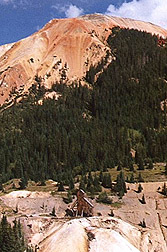This page has been archived and is being provided for reference purposes only. The page is no longer being updated, and therefore, links on the page may be invalid.
|
|
|
|
Paper Mill Waste May be Just Right for Reclaiming Mineland
By Don ComisOctober 28, 2008
Paper mill waste can safely be applied at a rate three times higher than the typical rate in Ohio, to reclaim soils of surface-coal mined areas.
Agricultural Research Service (ARS) soil scientist Martin J. Shipitalo found that a 300-ton-per-acre application rate had many benefits, and did not result in major additional negative effects on runoff water quality compared to the standard 100-ton-per-acre rate. Shipitalo is at the ARS North Appalachian Experimental Watershed in Coshocton, Ohio.
This is the first research project to determine the amount of paper mill sludge byproduct that can safely be applied to land without harming downstream water quality.
The project also involved the two Ohio agencies that must grant special approval for the 300-ton-per-acre rate: the Ohio Environmental Protection Agency and the Ohio Department of Natural Resources. And it involved representatives of the paper mill, mining and land reclamation industries.
Shipitalo and colleagues applied sludge from a paper mill to plots on steep slopes in southeast Ohio that had been recently surface-mined. Approximately 10 weeks after the application, grass was planted on the slopes.
The application of paper mill sludge at both rates greatly reduced runoff and erosion from the plots, particularly during the period before grass was planted. But the higher application rate still reduced soil loss 8-fold after the grass was planted and the land had stabilized. Both rates reduced runoff 3- to 6-fold in that same post-planting period.
The high rate of paper mill sludge application increased soil carbon levels, soil pH and calcium to a greater extent than the lower rate. These improvements in soil quality may contribute to more persistent increases in plant growth and continued reductions in runoff and erosion. Also, the large reduction in runoff and erosion could result in lower reclamation costs by reducing the size of required sediment ponds.
The only negative effect of the byproduct was a temporary reduction--up to 10 weeks--of oxygen in the runoff water, but total runoff was reduced.
A paper on this research will be published in the November-December 2008 issue of the Journal of Environmental Quality.
ARS is a scientific research agency of the U.S. Department of Agriculture.


